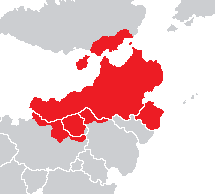User:Britbong64/Sandbox 4: Difference between revisions
Jump to navigation
Jump to search
Britbong64 (talk | contribs) (Created page with "{{Infobox former country |conventional_long_name = Rudolphine Confederation |common_name = Rudolphine Confederation |native_name = Eidgenossenschaft |era...") |
Britbong64 (talk | contribs) No edit summary |
||
| Line 37: | Line 37: | ||
|symbol = | |symbol = | ||
|symbol_type = | |symbol_type = | ||
|image_map = | |image_map = Rudolphine confed map.png | ||
|image_map_caption = | |image_map_caption = The Rudolphine Confederation at its greatest extent prior to the [[Amendist Wars]] in 1582. | ||
|image_map2 = | |image_map2 = | ||
|image_map2_caption = | |image_map2_caption = | ||
| Line 65: | Line 65: | ||
|coordinates = | |coordinates = | ||
}} | }} | ||
==History== | |||
*Founded in 900 after King Rudolf led the Eidgenossenschaft (oath-fellowship) against the Verliquoians/Estmerish preventing their expansion into northern Euclea. Rudolf was crowned as the Leader of the Eidgenossenschaft, commonly known as Emperor of the Rudolphine Confederation by Verliquoians. | |||
*The Rudolphines subsequently led wars of expansion, mainly to "crusade" against pagans integrating them as independent duchies. | |||
*Rivalry with the Third North Sea Empire in Caldia-Solstiana and Maritime Guild in Kirenia. | |||
*Reaches maximum extent prior to the Amendist wars. | |||
*Amendist Wars leads to civil war in the Confederation and many of its members to leave the authority of the Emperor. | |||
*Decline during the 17th century. | |||
*Ten Years' War leads to the further destruction of the Confederation. | |||
*Following the Ten Years' War the confederation begins centralising; this causes further discontent. | |||
*1785 - revolution creates a Kingdom of Werania, which then becomes a republic a year later. | |||
==Politics== | |||
*Kinda a mix between the Old Swiss Confederation and Holy Roman Empire. | |||
*Originally founded - basically when the Emperor requests troops to fight in a war, the constituent states send a levy. Most wars within the confederation are crusades against pagans(?) or against external threats. The central state also demands some taxes, but aside from that member states are basically autonomous. | |||
*Following the Amendist Wars the Federal Diet (Tagsatzung) is founded, which consists of representatives sent from the states. This leads to increased conflict between the emperor and the Tagsatzung. | |||
*Following the Ten Years' War far more centralisation is pursued - more taxes, more authority to the church, less respect for ancient privileges. Tagsatzung increasingly marginalised in favour of absolutism. | |||
Revision as of 22:44, 17 January 2021
Rudolphine Confederation Eidgenossenschaft | |
|---|---|
| 900-1786 | |
|
Imperial Banner | |
 The Rudolphine Confederation at its greatest extent prior to the Amendist Wars in 1582. | |
| Capital | No single/fixed capital |
| Common languages | Weranian, Medieval Solarian (administrative/liturgical/ceremonial), Aldman, Ruttish, Dellish, Estmerish, Azmaran (more) |
| Religion | Catholicism, Amendism |
| Government | Confederal elective monarchy |
| Rudolphine Emperor | |
• 900-916 | Rudolf I |
• 1774-17785 | Leopold III |
| Legislature | Tagsatzung |
| Historical era | Middle Ages Early modern period |
• Established | 900 |
• Disestablished | 1786 |
History
- Founded in 900 after King Rudolf led the Eidgenossenschaft (oath-fellowship) against the Verliquoians/Estmerish preventing their expansion into northern Euclea. Rudolf was crowned as the Leader of the Eidgenossenschaft, commonly known as Emperor of the Rudolphine Confederation by Verliquoians.
- The Rudolphines subsequently led wars of expansion, mainly to "crusade" against pagans integrating them as independent duchies.
- Rivalry with the Third North Sea Empire in Caldia-Solstiana and Maritime Guild in Kirenia.
- Reaches maximum extent prior to the Amendist wars.
- Amendist Wars leads to civil war in the Confederation and many of its members to leave the authority of the Emperor.
- Decline during the 17th century.
- Ten Years' War leads to the further destruction of the Confederation.
- Following the Ten Years' War the confederation begins centralising; this causes further discontent.
- 1785 - revolution creates a Kingdom of Werania, which then becomes a republic a year later.
Politics
- Kinda a mix between the Old Swiss Confederation and Holy Roman Empire.
- Originally founded - basically when the Emperor requests troops to fight in a war, the constituent states send a levy. Most wars within the confederation are crusades against pagans(?) or against external threats. The central state also demands some taxes, but aside from that member states are basically autonomous.
- Following the Amendist Wars the Federal Diet (Tagsatzung) is founded, which consists of representatives sent from the states. This leads to increased conflict between the emperor and the Tagsatzung.
- Following the Ten Years' War far more centralisation is pursued - more taxes, more authority to the church, less respect for ancient privileges. Tagsatzung increasingly marginalised in favour of absolutism.
